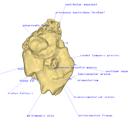3D models of Miocene vertebrates from Tavers
3D models of early strepsirrhine primate teeth from North Africa
3D model of Burmesescorpiops wunpawng
3D GM dataset of bird skeletal variation
Skeletal embryonic development in the catshark
Bony connexions of the petrosal bone of extant hippos
bony labyrinth (11) , inner ear (10) , Eocene (8) , South America (8) , Paleobiogeography (7) , skull (7) , phylogeny (6)
Lionel Hautier (22) , Maëva Judith Orliac (21) , Laurent Marivaux (16) , Rodolphe Tabuce (14) , Bastien Mennecart (13) , Pierre-Olivier Antoine (12) , Renaud Lebrun (11)
MorphoMuseuM Vol. 01, Issue 02
<< prev. article next article >>

|
Original article : anatomy atlasThe petrosal bone of Prodremotherium sp. (Artiodactyla, Ruminantia).Alexandre Assemat
Published online: 13/02/2015 |

|
M3#7Labelled 3D model of right isolated petrosal of Prodremotherium sp. from Pech de Fraysse (Quercy, MP 28) Type: "3D_surfaces"doi: 10.18563/m3.sf7 state:published |
Download 3D surface file |
Prodremotherium sp. UM PFY 4054 View specimen

|
M3#8Labelled 3D model of right isolated petrosal of Prodremotherium sp. from Pech de Fraysse (Quercy, MP 28) Type: "3D_surfaces"doi: 10.18563/m3.sf8 state:published |
Download 3D surface file |
BiochroM’97, 1997, Synthèses et tableaux de corré1ations/ Syntheses and correlation tables. In Aguilar, J.-P., Legendre, S., Michaux, J. (Eds.), Actes du Congrès BiochroM’97. Mémoires et Travaux de l’Ecole Pratique des Hautes Etudes, Institut de Montpellier 21:769-805.
Jehenne, Y., 1977. Description du premier crane du genre Prodremotherium Filhol, 1877 (ruminant primitif de l’Oligocène eurasiatique). Géobios Mémoire special 1, 233-237. http://dx.doi.org/10.1016/S0016-6995(77)80021-1
Lebrun, R., 2014. ISE-MeshTools, a 3D interactive fossil reconstruction freeware. 12th Annual Meeting of EAVP, Torino, Italy.
Métais, G., Vislobokova, I., 2007. Basal Ruminants. In Prothero, D. R., Foss, S., (Eds.), The Evolution of Artiodactyls. Baltimore: The Johns Hopkins University Press, pp. 189-212.
O’Leary, M. A., 2010. An anatomical and phylogenetic study of the osteology of the petrosal of extant and extinct artiodactylans (Mammalia) and relatives. Bulletin of the American Museum of Natural History 335, 206 pp. http://dx.doi.org/10.1206/335.1
Orliac, M. J., O’Leary, M. A., 2014. Comparative Anatomy of the Petrosal Bone of Dichobunoids, Early Members of Artiodactylamorpha (Mammalia). Journal of Mammalian Evolution 21, 299–320. http://dx.doi.org/10.1007/s10914-014-9254-9
Webb, S. D., Taylor, B. E., 1980. The phylogeny of hornless ruminants and a description of cranium of Archaeomeryx. Bulletin of the American Museum of Natural History, 167, 117-158.